Cadbury: Organisational Behaviour Report and Analysis
VerifiedAdded on 2020/10/23
|18
|5444
|140
Report
AI Summary
This report provides a comprehensive analysis of Cadbury's organisational behaviour. It begins with an introduction to organisational behaviour and its impact on Cadbury, followed by an examination of how organisational culture, power, and politics influence individual and team performance, referencing Handy's model for cultural analysis and different types of power. The report then delves into content and process theories of motivation, including Maslow's hierarchy of needs and Vroom's expectancy theory, to understand motivational techniques. Additionally, the report differentiates between effective and ineffective teams and concludes with a discussion of the concepts and philosophies of organisational behaviour in achieving organisational goals.
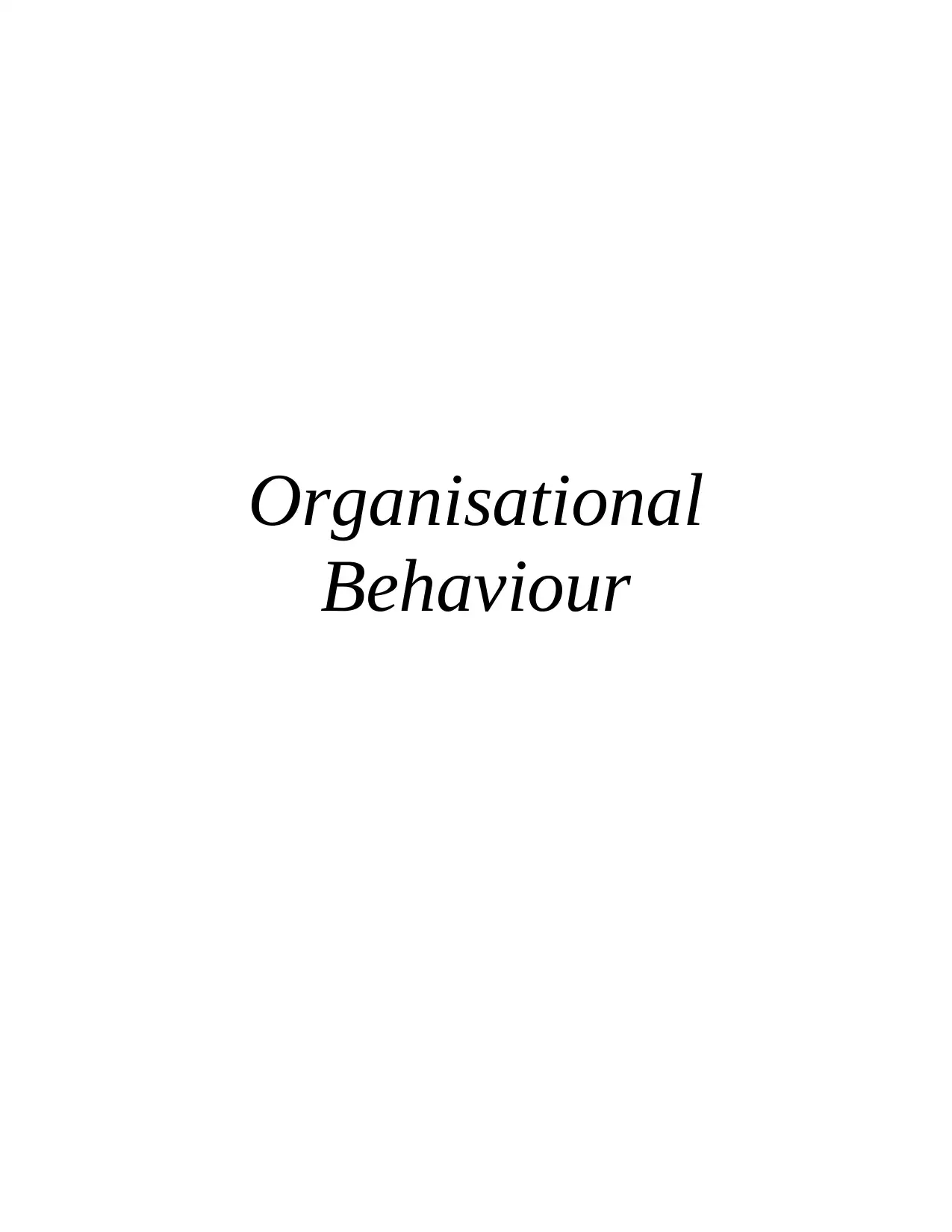
Organisational
Behaviour
Behaviour
Paraphrase This Document
Need a fresh take? Get an instant paraphrase of this document with our AI Paraphraser
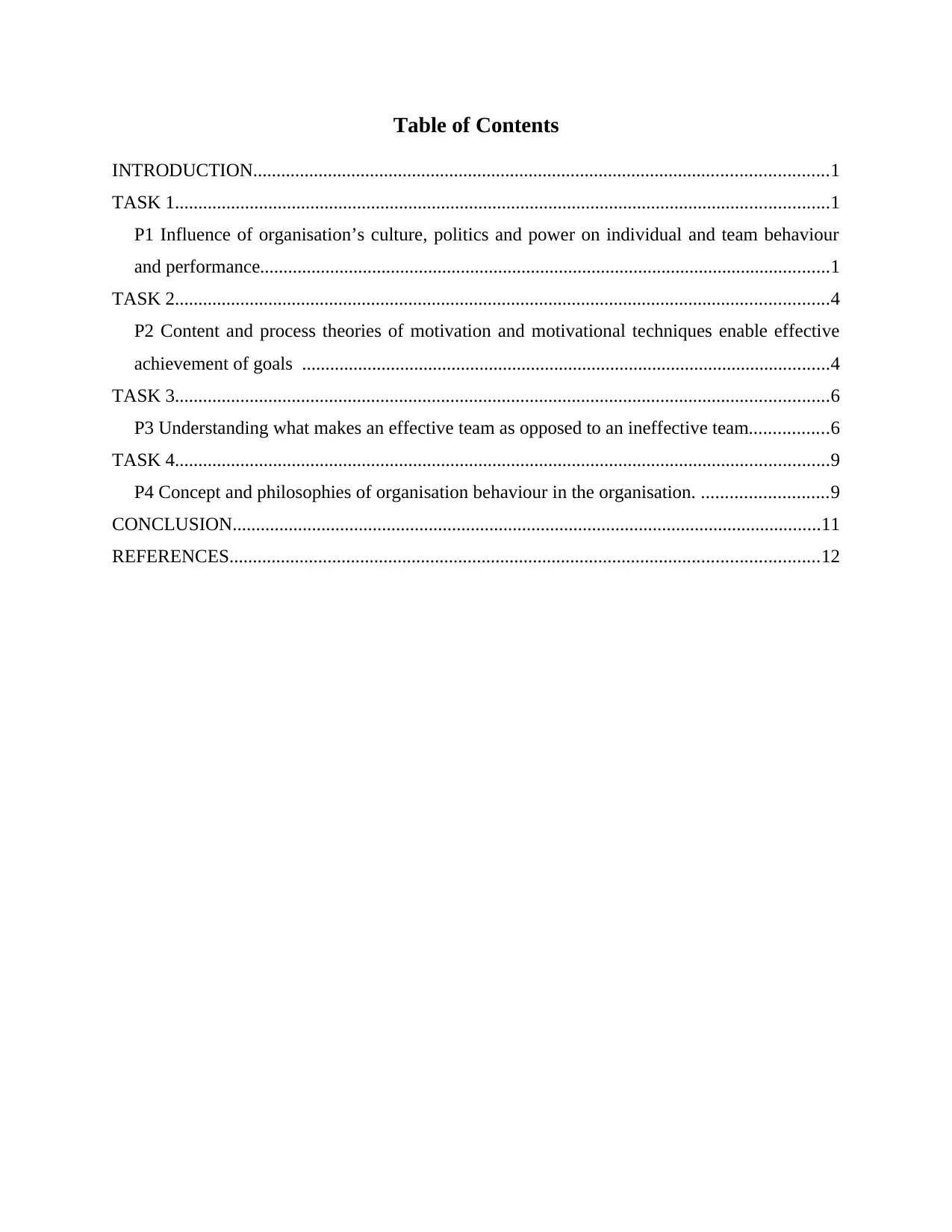
Table of Contents
INTRODUCTION...........................................................................................................................1
TASK 1............................................................................................................................................1
P1 Influence of organisation’s culture, politics and power on individual and team behaviour
and performance..........................................................................................................................1
TASK 2............................................................................................................................................4
P2 Content and process theories of motivation and motivational techniques enable effective
achievement of goals .................................................................................................................4
TASK 3............................................................................................................................................6
P3 Understanding what makes an effective team as opposed to an ineffective team.................6
TASK 4............................................................................................................................................9
P4 Concept and philosophies of organisation behaviour in the organisation. ...........................9
CONCLUSION..............................................................................................................................11
REFERENCES..............................................................................................................................12
INTRODUCTION...........................................................................................................................1
TASK 1............................................................................................................................................1
P1 Influence of organisation’s culture, politics and power on individual and team behaviour
and performance..........................................................................................................................1
TASK 2............................................................................................................................................4
P2 Content and process theories of motivation and motivational techniques enable effective
achievement of goals .................................................................................................................4
TASK 3............................................................................................................................................6
P3 Understanding what makes an effective team as opposed to an ineffective team.................6
TASK 4............................................................................................................................................9
P4 Concept and philosophies of organisation behaviour in the organisation. ...........................9
CONCLUSION..............................................................................................................................11
REFERENCES..............................................................................................................................12

⊘ This is a preview!⊘
Do you want full access?
Subscribe today to unlock all pages.

Trusted by 1+ million students worldwide
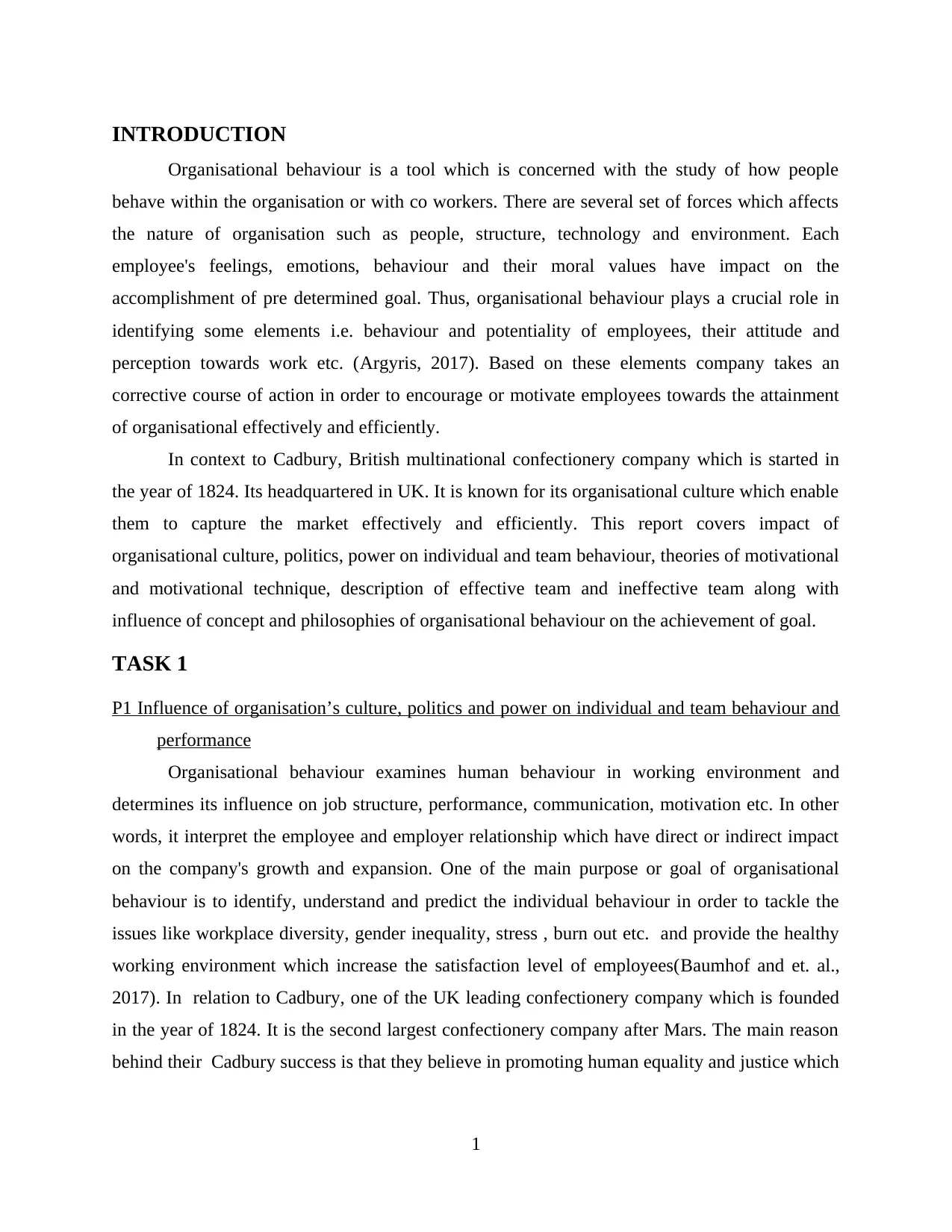
INTRODUCTION
Organisational behaviour is a tool which is concerned with the study of how people
behave within the organisation or with co workers. There are several set of forces which affects
the nature of organisation such as people, structure, technology and environment. Each
employee's feelings, emotions, behaviour and their moral values have impact on the
accomplishment of pre determined goal. Thus, organisational behaviour plays a crucial role in
identifying some elements i.e. behaviour and potentiality of employees, their attitude and
perception towards work etc. (Argyris, 2017). Based on these elements company takes an
corrective course of action in order to encourage or motivate employees towards the attainment
of organisational effectively and efficiently.
In context to Cadbury, British multinational confectionery company which is started in
the year of 1824. Its headquartered in UK. It is known for its organisational culture which enable
them to capture the market effectively and efficiently. This report covers impact of
organisational culture, politics, power on individual and team behaviour, theories of motivational
and motivational technique, description of effective team and ineffective team along with
influence of concept and philosophies of organisational behaviour on the achievement of goal.
TASK 1
P1 Influence of organisation’s culture, politics and power on individual and team behaviour and
performance
Organisational behaviour examines human behaviour in working environment and
determines its influence on job structure, performance, communication, motivation etc. In other
words, it interpret the employee and employer relationship which have direct or indirect impact
on the company's growth and expansion. One of the main purpose or goal of organisational
behaviour is to identify, understand and predict the individual behaviour in order to tackle the
issues like workplace diversity, gender inequality, stress , burn out etc. and provide the healthy
working environment which increase the satisfaction level of employees(Baumhof and et. al.,
2017). In relation to Cadbury, one of the UK leading confectionery company which is founded
in the year of 1824. It is the second largest confectionery company after Mars. The main reason
behind their Cadbury success is that they believe in promoting human equality and justice which
1
Organisational behaviour is a tool which is concerned with the study of how people
behave within the organisation or with co workers. There are several set of forces which affects
the nature of organisation such as people, structure, technology and environment. Each
employee's feelings, emotions, behaviour and their moral values have impact on the
accomplishment of pre determined goal. Thus, organisational behaviour plays a crucial role in
identifying some elements i.e. behaviour and potentiality of employees, their attitude and
perception towards work etc. (Argyris, 2017). Based on these elements company takes an
corrective course of action in order to encourage or motivate employees towards the attainment
of organisational effectively and efficiently.
In context to Cadbury, British multinational confectionery company which is started in
the year of 1824. Its headquartered in UK. It is known for its organisational culture which enable
them to capture the market effectively and efficiently. This report covers impact of
organisational culture, politics, power on individual and team behaviour, theories of motivational
and motivational technique, description of effective team and ineffective team along with
influence of concept and philosophies of organisational behaviour on the achievement of goal.
TASK 1
P1 Influence of organisation’s culture, politics and power on individual and team behaviour and
performance
Organisational behaviour examines human behaviour in working environment and
determines its influence on job structure, performance, communication, motivation etc. In other
words, it interpret the employee and employer relationship which have direct or indirect impact
on the company's growth and expansion. One of the main purpose or goal of organisational
behaviour is to identify, understand and predict the individual behaviour in order to tackle the
issues like workplace diversity, gender inequality, stress , burn out etc. and provide the healthy
working environment which increase the satisfaction level of employees(Baumhof and et. al.,
2017). In relation to Cadbury, one of the UK leading confectionery company which is founded
in the year of 1824. It is the second largest confectionery company after Mars. The main reason
behind their Cadbury success is that they believe in promoting human equality and justice which
1
Paraphrase This Document
Need a fresh take? Get an instant paraphrase of this document with our AI Paraphraser
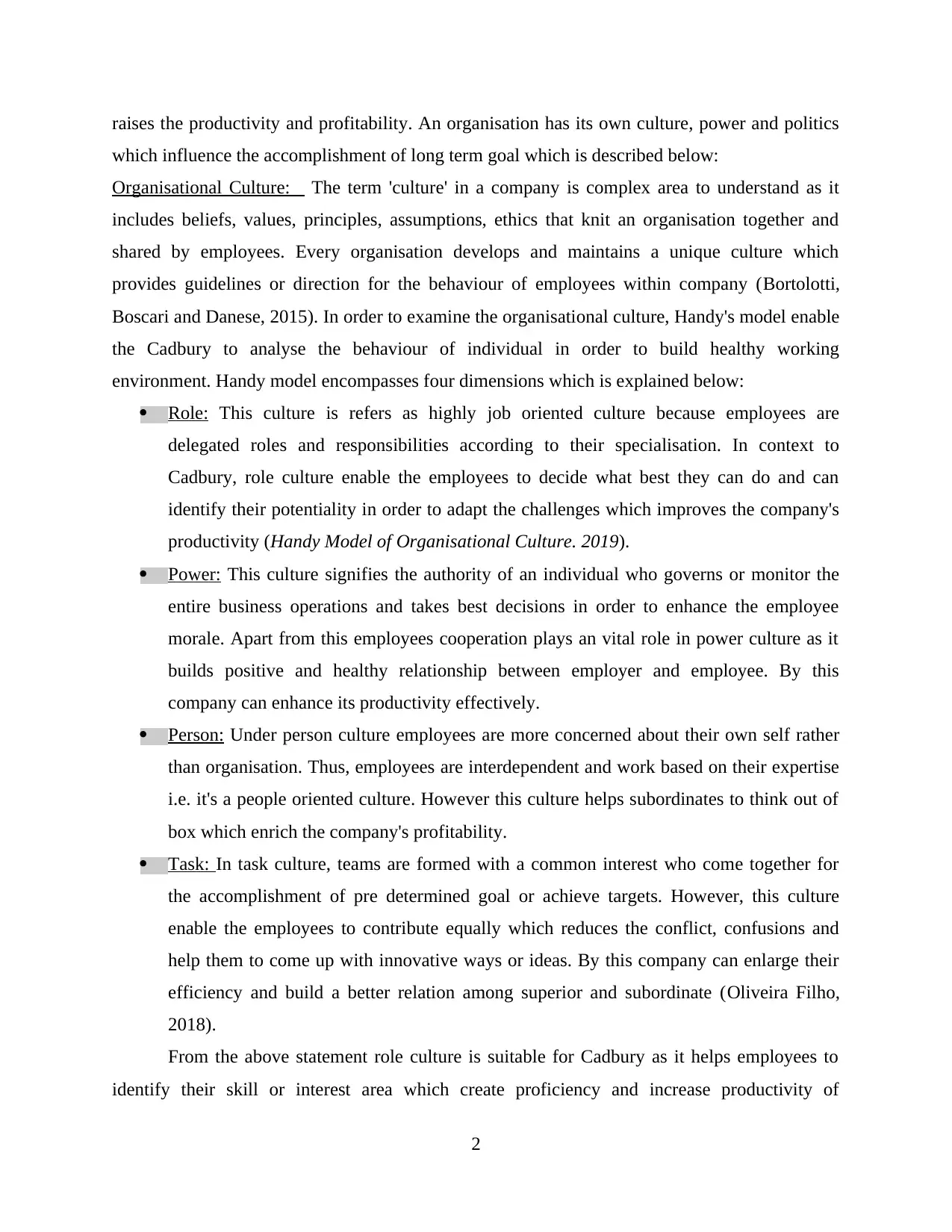
raises the productivity and profitability. An organisation has its own culture, power and politics
which influence the accomplishment of long term goal which is described below:
Organisational Culture: The term 'culture' in a company is complex area to understand as it
includes beliefs, values, principles, assumptions, ethics that knit an organisation together and
shared by employees. Every organisation develops and maintains a unique culture which
provides guidelines or direction for the behaviour of employees within company (Bortolotti,
Boscari and Danese, 2015). In order to examine the organisational culture, Handy's model enable
the Cadbury to analyse the behaviour of individual in order to build healthy working
environment. Handy model encompasses four dimensions which is explained below:
Role: This culture is refers as highly job oriented culture because employees are
delegated roles and responsibilities according to their specialisation. In context to
Cadbury, role culture enable the employees to decide what best they can do and can
identify their potentiality in order to adapt the challenges which improves the company's
productivity (Handy Model of Organisational Culture. 2019).
Power: This culture signifies the authority of an individual who governs or monitor the
entire business operations and takes best decisions in order to enhance the employee
morale. Apart from this employees cooperation plays an vital role in power culture as it
builds positive and healthy relationship between employer and employee. By this
company can enhance its productivity effectively.
Person: Under person culture employees are more concerned about their own self rather
than organisation. Thus, employees are interdependent and work based on their expertise
i.e. it's a people oriented culture. However this culture helps subordinates to think out of
box which enrich the company's profitability.
Task: In task culture, teams are formed with a common interest who come together for
the accomplishment of pre determined goal or achieve targets. However, this culture
enable the employees to contribute equally which reduces the conflict, confusions and
help them to come up with innovative ways or ideas. By this company can enlarge their
efficiency and build a better relation among superior and subordinate (Oliveira Filho,
2018).
From the above statement role culture is suitable for Cadbury as it helps employees to
identify their skill or interest area which create proficiency and increase productivity of
2
which influence the accomplishment of long term goal which is described below:
Organisational Culture: The term 'culture' in a company is complex area to understand as it
includes beliefs, values, principles, assumptions, ethics that knit an organisation together and
shared by employees. Every organisation develops and maintains a unique culture which
provides guidelines or direction for the behaviour of employees within company (Bortolotti,
Boscari and Danese, 2015). In order to examine the organisational culture, Handy's model enable
the Cadbury to analyse the behaviour of individual in order to build healthy working
environment. Handy model encompasses four dimensions which is explained below:
Role: This culture is refers as highly job oriented culture because employees are
delegated roles and responsibilities according to their specialisation. In context to
Cadbury, role culture enable the employees to decide what best they can do and can
identify their potentiality in order to adapt the challenges which improves the company's
productivity (Handy Model of Organisational Culture. 2019).
Power: This culture signifies the authority of an individual who governs or monitor the
entire business operations and takes best decisions in order to enhance the employee
morale. Apart from this employees cooperation plays an vital role in power culture as it
builds positive and healthy relationship between employer and employee. By this
company can enhance its productivity effectively.
Person: Under person culture employees are more concerned about their own self rather
than organisation. Thus, employees are interdependent and work based on their expertise
i.e. it's a people oriented culture. However this culture helps subordinates to think out of
box which enrich the company's profitability.
Task: In task culture, teams are formed with a common interest who come together for
the accomplishment of pre determined goal or achieve targets. However, this culture
enable the employees to contribute equally which reduces the conflict, confusions and
help them to come up with innovative ways or ideas. By this company can enlarge their
efficiency and build a better relation among superior and subordinate (Oliveira Filho,
2018).
From the above statement role culture is suitable for Cadbury as it helps employees to
identify their skill or interest area which create proficiency and increase productivity of
2
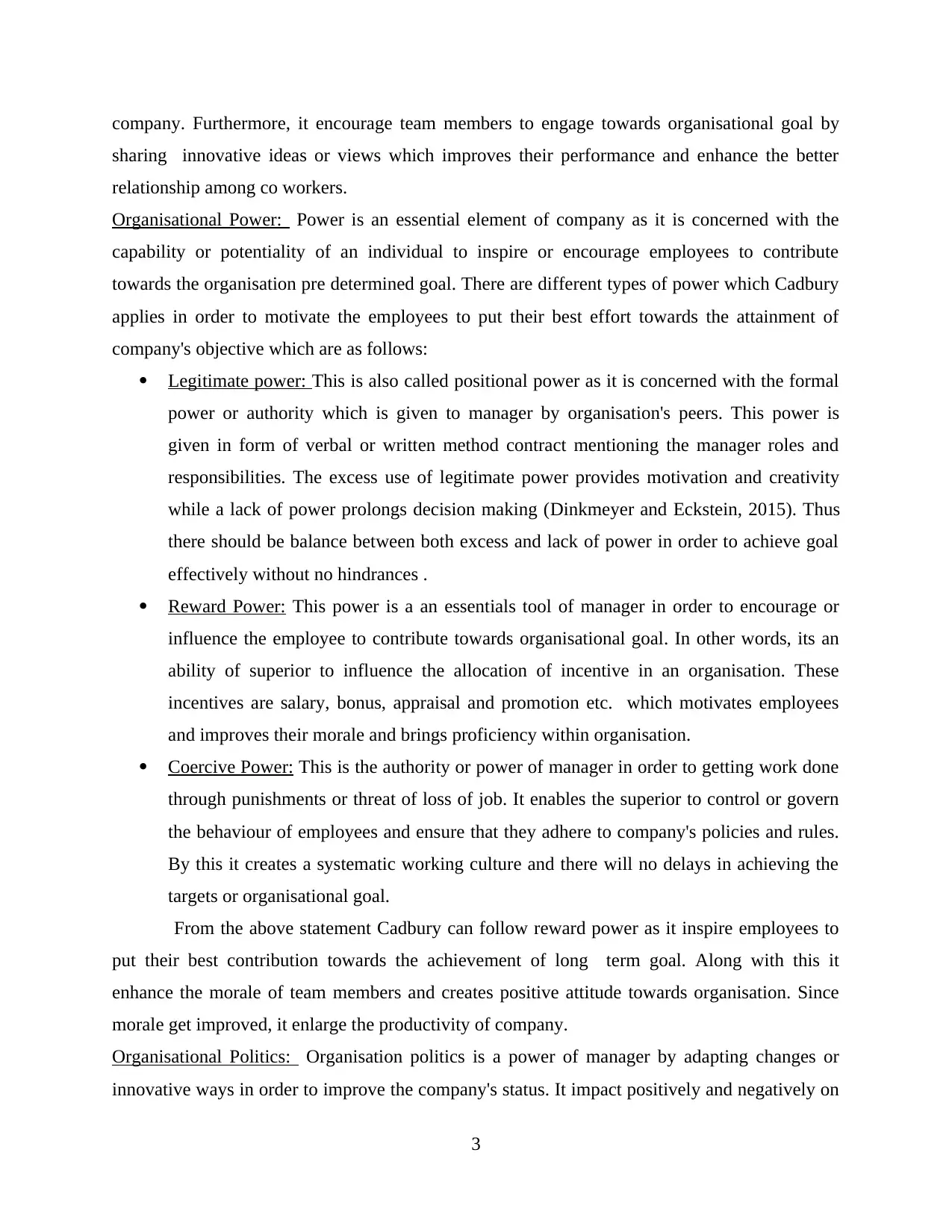
company. Furthermore, it encourage team members to engage towards organisational goal by
sharing innovative ideas or views which improves their performance and enhance the better
relationship among co workers.
Organisational Power: Power is an essential element of company as it is concerned with the
capability or potentiality of an individual to inspire or encourage employees to contribute
towards the organisation pre determined goal. There are different types of power which Cadbury
applies in order to motivate the employees to put their best effort towards the attainment of
company's objective which are as follows:
Legitimate power: This is also called positional power as it is concerned with the formal
power or authority which is given to manager by organisation's peers. This power is
given in form of verbal or written method contract mentioning the manager roles and
responsibilities. The excess use of legitimate power provides motivation and creativity
while a lack of power prolongs decision making (Dinkmeyer and Eckstein, 2015). Thus
there should be balance between both excess and lack of power in order to achieve goal
effectively without no hindrances .
Reward Power: This power is a an essentials tool of manager in order to encourage or
influence the employee to contribute towards organisational goal. In other words, its an
ability of superior to influence the allocation of incentive in an organisation. These
incentives are salary, bonus, appraisal and promotion etc. which motivates employees
and improves their morale and brings proficiency within organisation.
Coercive Power: This is the authority or power of manager in order to getting work done
through punishments or threat of loss of job. It enables the superior to control or govern
the behaviour of employees and ensure that they adhere to company's policies and rules.
By this it creates a systematic working culture and there will no delays in achieving the
targets or organisational goal.
From the above statement Cadbury can follow reward power as it inspire employees to
put their best contribution towards the achievement of long term goal. Along with this it
enhance the morale of team members and creates positive attitude towards organisation. Since
morale get improved, it enlarge the productivity of company.
Organisational Politics: Organisation politics is a power of manager by adapting changes or
innovative ways in order to improve the company's status. It impact positively and negatively on
3
sharing innovative ideas or views which improves their performance and enhance the better
relationship among co workers.
Organisational Power: Power is an essential element of company as it is concerned with the
capability or potentiality of an individual to inspire or encourage employees to contribute
towards the organisation pre determined goal. There are different types of power which Cadbury
applies in order to motivate the employees to put their best effort towards the attainment of
company's objective which are as follows:
Legitimate power: This is also called positional power as it is concerned with the formal
power or authority which is given to manager by organisation's peers. This power is
given in form of verbal or written method contract mentioning the manager roles and
responsibilities. The excess use of legitimate power provides motivation and creativity
while a lack of power prolongs decision making (Dinkmeyer and Eckstein, 2015). Thus
there should be balance between both excess and lack of power in order to achieve goal
effectively without no hindrances .
Reward Power: This power is a an essentials tool of manager in order to encourage or
influence the employee to contribute towards organisational goal. In other words, its an
ability of superior to influence the allocation of incentive in an organisation. These
incentives are salary, bonus, appraisal and promotion etc. which motivates employees
and improves their morale and brings proficiency within organisation.
Coercive Power: This is the authority or power of manager in order to getting work done
through punishments or threat of loss of job. It enables the superior to control or govern
the behaviour of employees and ensure that they adhere to company's policies and rules.
By this it creates a systematic working culture and there will no delays in achieving the
targets or organisational goal.
From the above statement Cadbury can follow reward power as it inspire employees to
put their best contribution towards the achievement of long term goal. Along with this it
enhance the morale of team members and creates positive attitude towards organisation. Since
morale get improved, it enlarge the productivity of company.
Organisational Politics: Organisation politics is a power of manager by adapting changes or
innovative ways in order to improve the company's status. It impact positively and negatively on
3
⊘ This is a preview!⊘
Do you want full access?
Subscribe today to unlock all pages.

Trusted by 1+ million students worldwide
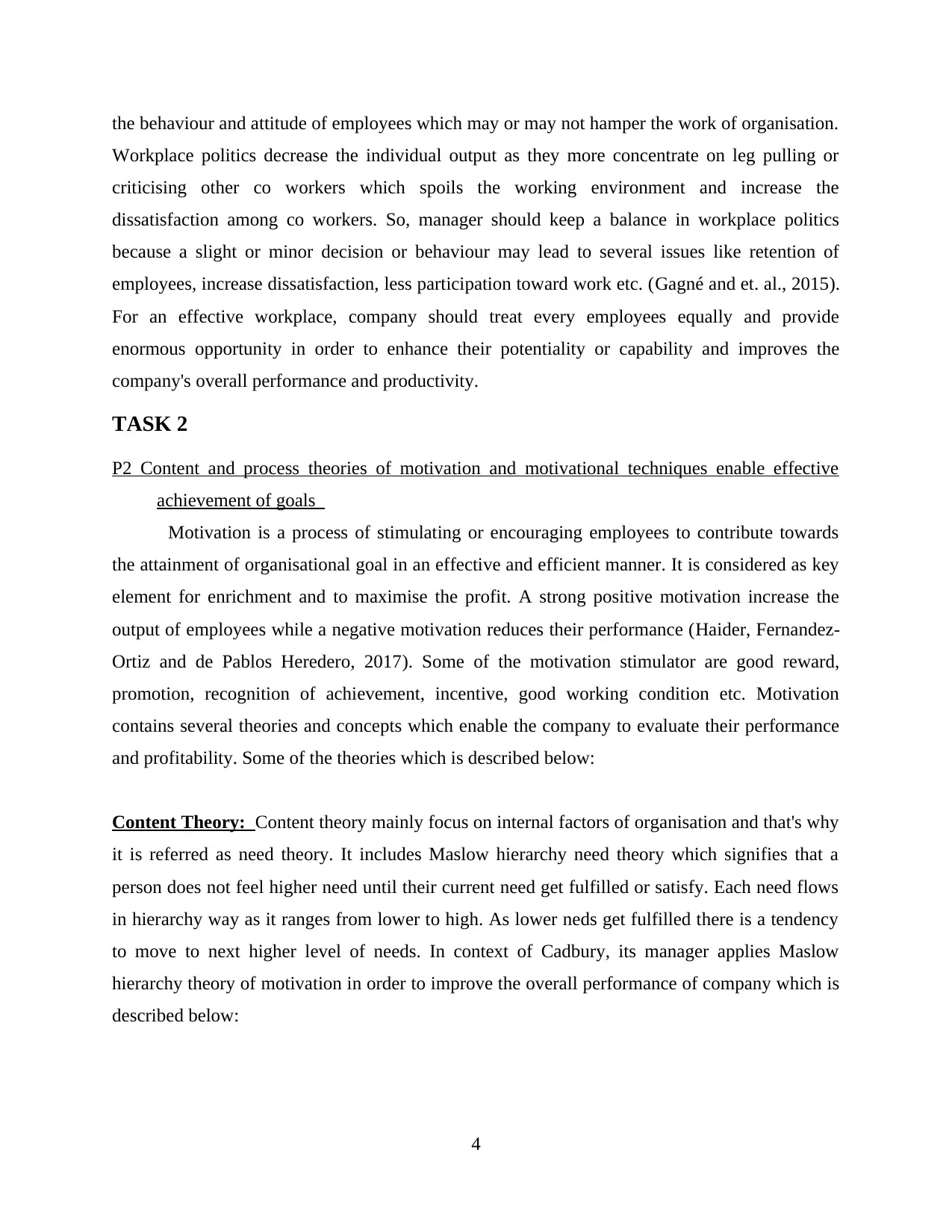
the behaviour and attitude of employees which may or may not hamper the work of organisation.
Workplace politics decrease the individual output as they more concentrate on leg pulling or
criticising other co workers which spoils the working environment and increase the
dissatisfaction among co workers. So, manager should keep a balance in workplace politics
because a slight or minor decision or behaviour may lead to several issues like retention of
employees, increase dissatisfaction, less participation toward work etc. (Gagné and et. al., 2015).
For an effective workplace, company should treat every employees equally and provide
enormous opportunity in order to enhance their potentiality or capability and improves the
company's overall performance and productivity.
TASK 2
P2 Content and process theories of motivation and motivational techniques enable effective
achievement of goals
Motivation is a process of stimulating or encouraging employees to contribute towards
the attainment of organisational goal in an effective and efficient manner. It is considered as key
element for enrichment and to maximise the profit. A strong positive motivation increase the
output of employees while a negative motivation reduces their performance (Haider, Fernandez-
Ortiz and de Pablos Heredero, 2017). Some of the motivation stimulator are good reward,
promotion, recognition of achievement, incentive, good working condition etc. Motivation
contains several theories and concepts which enable the company to evaluate their performance
and profitability. Some of the theories which is described below:
Content Theory: Content theory mainly focus on internal factors of organisation and that's why
it is referred as need theory. It includes Maslow hierarchy need theory which signifies that a
person does not feel higher need until their current need get fulfilled or satisfy. Each need flows
in hierarchy way as it ranges from lower to high. As lower neds get fulfilled there is a tendency
to move to next higher level of needs. In context of Cadbury, its manager applies Maslow
hierarchy theory of motivation in order to improve the overall performance of company which is
described below:
4
Workplace politics decrease the individual output as they more concentrate on leg pulling or
criticising other co workers which spoils the working environment and increase the
dissatisfaction among co workers. So, manager should keep a balance in workplace politics
because a slight or minor decision or behaviour may lead to several issues like retention of
employees, increase dissatisfaction, less participation toward work etc. (Gagné and et. al., 2015).
For an effective workplace, company should treat every employees equally and provide
enormous opportunity in order to enhance their potentiality or capability and improves the
company's overall performance and productivity.
TASK 2
P2 Content and process theories of motivation and motivational techniques enable effective
achievement of goals
Motivation is a process of stimulating or encouraging employees to contribute towards
the attainment of organisational goal in an effective and efficient manner. It is considered as key
element for enrichment and to maximise the profit. A strong positive motivation increase the
output of employees while a negative motivation reduces their performance (Haider, Fernandez-
Ortiz and de Pablos Heredero, 2017). Some of the motivation stimulator are good reward,
promotion, recognition of achievement, incentive, good working condition etc. Motivation
contains several theories and concepts which enable the company to evaluate their performance
and profitability. Some of the theories which is described below:
Content Theory: Content theory mainly focus on internal factors of organisation and that's why
it is referred as need theory. It includes Maslow hierarchy need theory which signifies that a
person does not feel higher need until their current need get fulfilled or satisfy. Each need flows
in hierarchy way as it ranges from lower to high. As lower neds get fulfilled there is a tendency
to move to next higher level of needs. In context of Cadbury, its manager applies Maslow
hierarchy theory of motivation in order to improve the overall performance of company which is
described below:
4
Paraphrase This Document
Need a fresh take? Get an instant paraphrase of this document with our AI Paraphraser
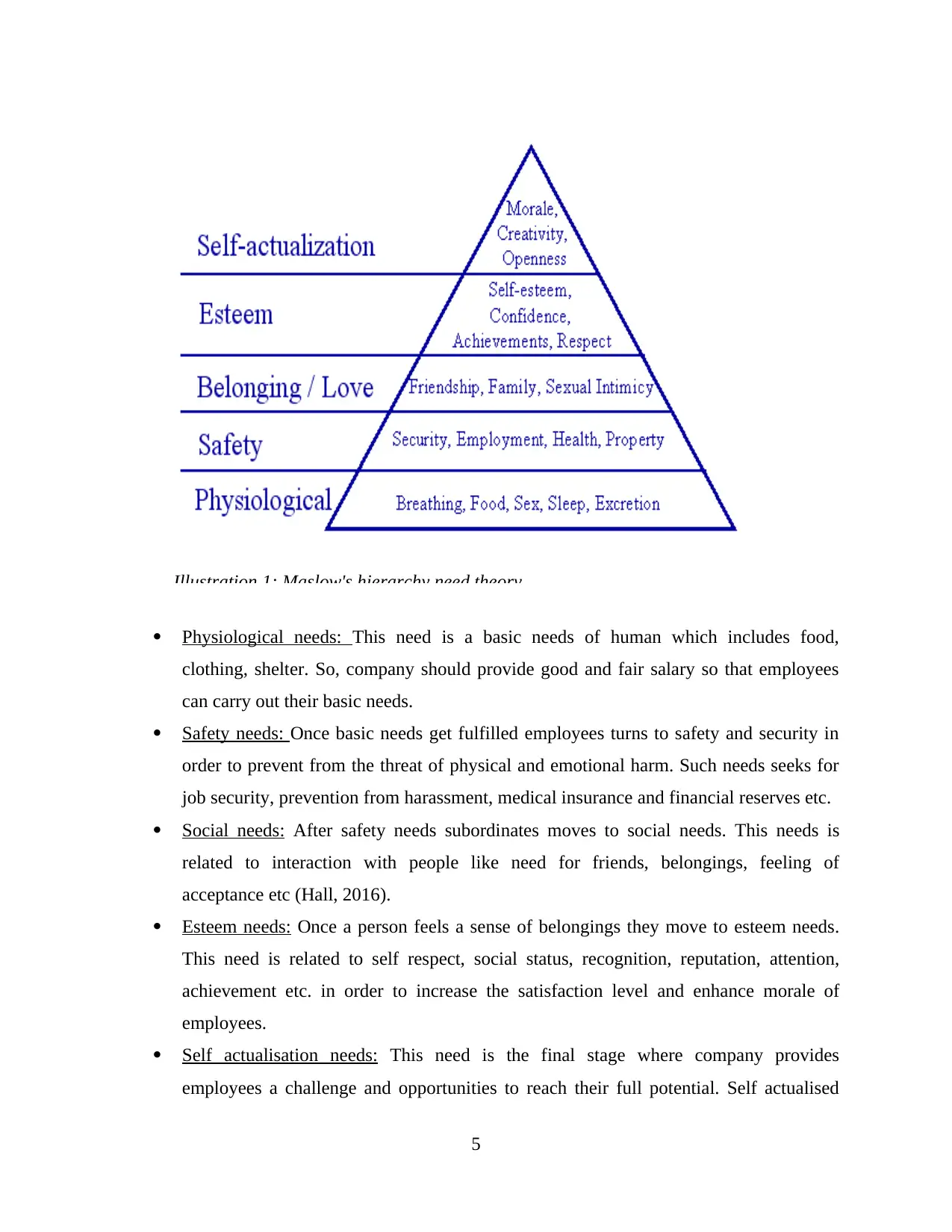
Physiological needs: This need is a basic needs of human which includes food,
clothing, shelter. So, company should provide good and fair salary so that employees
can carry out their basic needs.
Safety needs: Once basic needs get fulfilled employees turns to safety and security in
order to prevent from the threat of physical and emotional harm. Such needs seeks for
job security, prevention from harassment, medical insurance and financial reserves etc.
Social needs: After safety needs subordinates moves to social needs. This needs is
related to interaction with people like need for friends, belongings, feeling of
acceptance etc (Hall, 2016).
Esteem needs: Once a person feels a sense of belongings they move to esteem needs.
This need is related to self respect, social status, recognition, reputation, attention,
achievement etc. in order to increase the satisfaction level and enhance morale of
employees.
Self actualisation needs: This need is the final stage where company provides
employees a challenge and opportunities to reach their full potential. Self actualised
5
Illustration 1: Maslow's hierarchy need theory
clothing, shelter. So, company should provide good and fair salary so that employees
can carry out their basic needs.
Safety needs: Once basic needs get fulfilled employees turns to safety and security in
order to prevent from the threat of physical and emotional harm. Such needs seeks for
job security, prevention from harassment, medical insurance and financial reserves etc.
Social needs: After safety needs subordinates moves to social needs. This needs is
related to interaction with people like need for friends, belongings, feeling of
acceptance etc (Hall, 2016).
Esteem needs: Once a person feels a sense of belongings they move to esteem needs.
This need is related to self respect, social status, recognition, reputation, attention,
achievement etc. in order to increase the satisfaction level and enhance morale of
employees.
Self actualisation needs: This need is the final stage where company provides
employees a challenge and opportunities to reach their full potential. Self actualised
5
Illustration 1: Maslow's hierarchy need theory
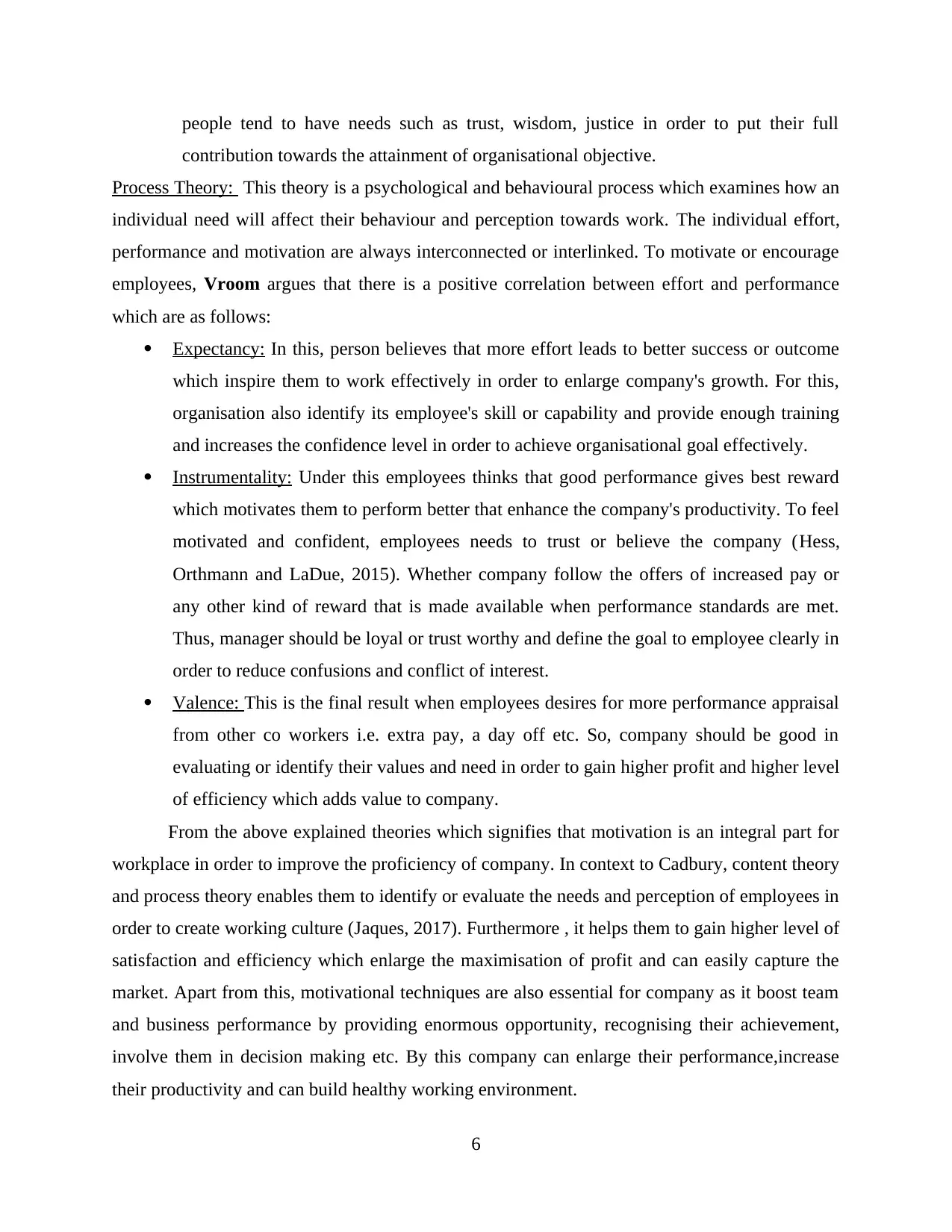
people tend to have needs such as trust, wisdom, justice in order to put their full
contribution towards the attainment of organisational objective.
Process Theory: This theory is a psychological and behavioural process which examines how an
individual need will affect their behaviour and perception towards work. The individual effort,
performance and motivation are always interconnected or interlinked. To motivate or encourage
employees, Vroom argues that there is a positive correlation between effort and performance
which are as follows:
Expectancy: In this, person believes that more effort leads to better success or outcome
which inspire them to work effectively in order to enlarge company's growth. For this,
organisation also identify its employee's skill or capability and provide enough training
and increases the confidence level in order to achieve organisational goal effectively.
Instrumentality: Under this employees thinks that good performance gives best reward
which motivates them to perform better that enhance the company's productivity. To feel
motivated and confident, employees needs to trust or believe the company (Hess,
Orthmann and LaDue, 2015). Whether company follow the offers of increased pay or
any other kind of reward that is made available when performance standards are met.
Thus, manager should be loyal or trust worthy and define the goal to employee clearly in
order to reduce confusions and conflict of interest.
Valence: This is the final result when employees desires for more performance appraisal
from other co workers i.e. extra pay, a day off etc. So, company should be good in
evaluating or identify their values and need in order to gain higher profit and higher level
of efficiency which adds value to company.
From the above explained theories which signifies that motivation is an integral part for
workplace in order to improve the proficiency of company. In context to Cadbury, content theory
and process theory enables them to identify or evaluate the needs and perception of employees in
order to create working culture (Jaques, 2017). Furthermore , it helps them to gain higher level of
satisfaction and efficiency which enlarge the maximisation of profit and can easily capture the
market. Apart from this, motivational techniques are also essential for company as it boost team
and business performance by providing enormous opportunity, recognising their achievement,
involve them in decision making etc. By this company can enlarge their performance,increase
their productivity and can build healthy working environment.
6
contribution towards the attainment of organisational objective.
Process Theory: This theory is a psychological and behavioural process which examines how an
individual need will affect their behaviour and perception towards work. The individual effort,
performance and motivation are always interconnected or interlinked. To motivate or encourage
employees, Vroom argues that there is a positive correlation between effort and performance
which are as follows:
Expectancy: In this, person believes that more effort leads to better success or outcome
which inspire them to work effectively in order to enlarge company's growth. For this,
organisation also identify its employee's skill or capability and provide enough training
and increases the confidence level in order to achieve organisational goal effectively.
Instrumentality: Under this employees thinks that good performance gives best reward
which motivates them to perform better that enhance the company's productivity. To feel
motivated and confident, employees needs to trust or believe the company (Hess,
Orthmann and LaDue, 2015). Whether company follow the offers of increased pay or
any other kind of reward that is made available when performance standards are met.
Thus, manager should be loyal or trust worthy and define the goal to employee clearly in
order to reduce confusions and conflict of interest.
Valence: This is the final result when employees desires for more performance appraisal
from other co workers i.e. extra pay, a day off etc. So, company should be good in
evaluating or identify their values and need in order to gain higher profit and higher level
of efficiency which adds value to company.
From the above explained theories which signifies that motivation is an integral part for
workplace in order to improve the proficiency of company. In context to Cadbury, content theory
and process theory enables them to identify or evaluate the needs and perception of employees in
order to create working culture (Jaques, 2017). Furthermore , it helps them to gain higher level of
satisfaction and efficiency which enlarge the maximisation of profit and can easily capture the
market. Apart from this, motivational techniques are also essential for company as it boost team
and business performance by providing enormous opportunity, recognising their achievement,
involve them in decision making etc. By this company can enlarge their performance,increase
their productivity and can build healthy working environment.
6
⊘ This is a preview!⊘
Do you want full access?
Subscribe today to unlock all pages.

Trusted by 1+ million students worldwide
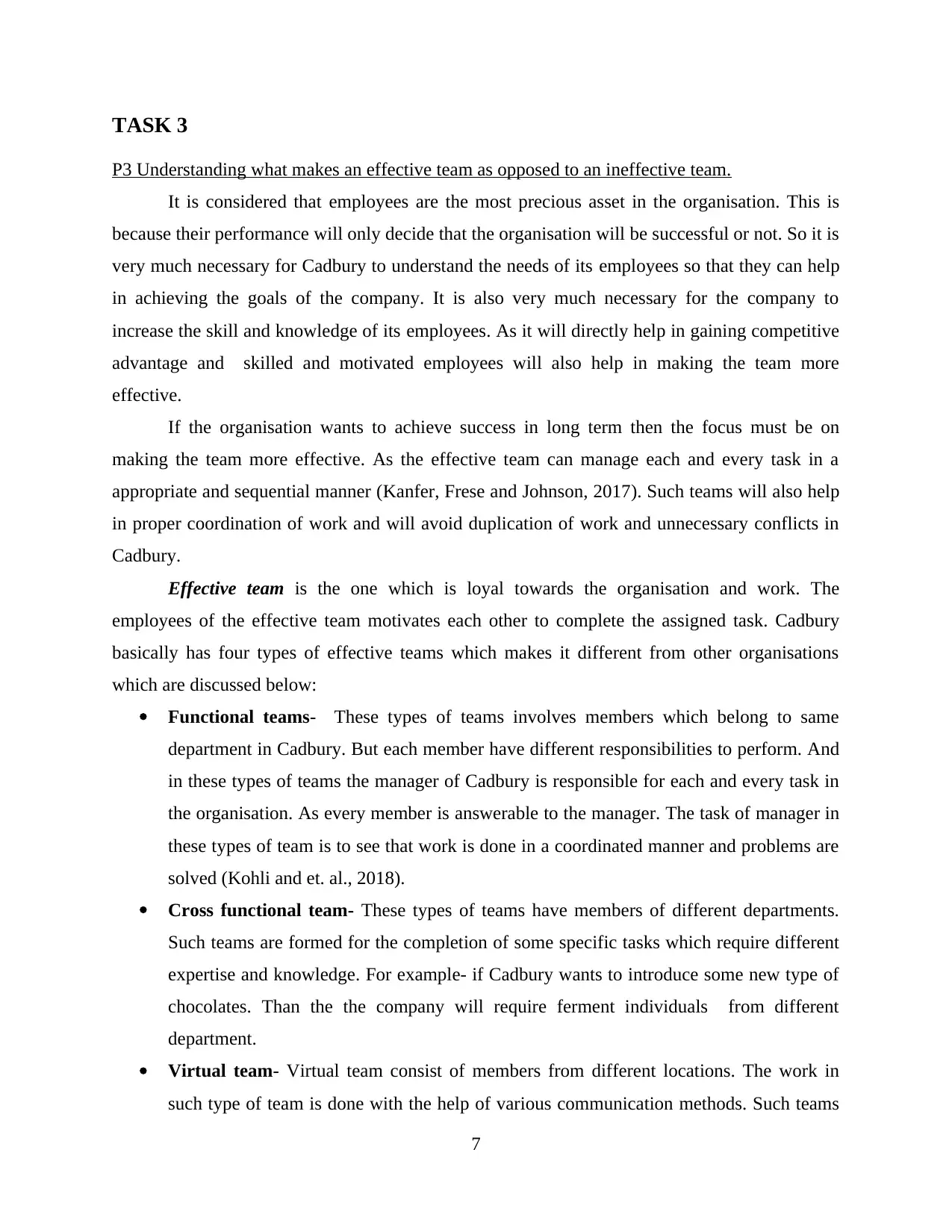
TASK 3
P3 Understanding what makes an effective team as opposed to an ineffective team.
It is considered that employees are the most precious asset in the organisation. This is
because their performance will only decide that the organisation will be successful or not. So it is
very much necessary for Cadbury to understand the needs of its employees so that they can help
in achieving the goals of the company. It is also very much necessary for the company to
increase the skill and knowledge of its employees. As it will directly help in gaining competitive
advantage and skilled and motivated employees will also help in making the team more
effective.
If the organisation wants to achieve success in long term then the focus must be on
making the team more effective. As the effective team can manage each and every task in a
appropriate and sequential manner (Kanfer, Frese and Johnson, 2017). Such teams will also help
in proper coordination of work and will avoid duplication of work and unnecessary conflicts in
Cadbury.
Effective team is the one which is loyal towards the organisation and work. The
employees of the effective team motivates each other to complete the assigned task. Cadbury
basically has four types of effective teams which makes it different from other organisations
which are discussed below:
Functional teams- These types of teams involves members which belong to same
department in Cadbury. But each member have different responsibilities to perform. And
in these types of teams the manager of Cadbury is responsible for each and every task in
the organisation. As every member is answerable to the manager. The task of manager in
these types of team is to see that work is done in a coordinated manner and problems are
solved (Kohli and et. al., 2018).
Cross functional team- These types of teams have members of different departments.
Such teams are formed for the completion of some specific tasks which require different
expertise and knowledge. For example- if Cadbury wants to introduce some new type of
chocolates. Than the the company will require ferment individuals from different
department.
Virtual team- Virtual team consist of members from different locations. The work in
such type of team is done with the help of various communication methods. Such teams
7
P3 Understanding what makes an effective team as opposed to an ineffective team.
It is considered that employees are the most precious asset in the organisation. This is
because their performance will only decide that the organisation will be successful or not. So it is
very much necessary for Cadbury to understand the needs of its employees so that they can help
in achieving the goals of the company. It is also very much necessary for the company to
increase the skill and knowledge of its employees. As it will directly help in gaining competitive
advantage and skilled and motivated employees will also help in making the team more
effective.
If the organisation wants to achieve success in long term then the focus must be on
making the team more effective. As the effective team can manage each and every task in a
appropriate and sequential manner (Kanfer, Frese and Johnson, 2017). Such teams will also help
in proper coordination of work and will avoid duplication of work and unnecessary conflicts in
Cadbury.
Effective team is the one which is loyal towards the organisation and work. The
employees of the effective team motivates each other to complete the assigned task. Cadbury
basically has four types of effective teams which makes it different from other organisations
which are discussed below:
Functional teams- These types of teams involves members which belong to same
department in Cadbury. But each member have different responsibilities to perform. And
in these types of teams the manager of Cadbury is responsible for each and every task in
the organisation. As every member is answerable to the manager. The task of manager in
these types of team is to see that work is done in a coordinated manner and problems are
solved (Kohli and et. al., 2018).
Cross functional team- These types of teams have members of different departments.
Such teams are formed for the completion of some specific tasks which require different
expertise and knowledge. For example- if Cadbury wants to introduce some new type of
chocolates. Than the the company will require ferment individuals from different
department.
Virtual team- Virtual team consist of members from different locations. The work in
such type of team is done with the help of various communication methods. Such teams
7
Paraphrase This Document
Need a fresh take? Get an instant paraphrase of this document with our AI Paraphraser
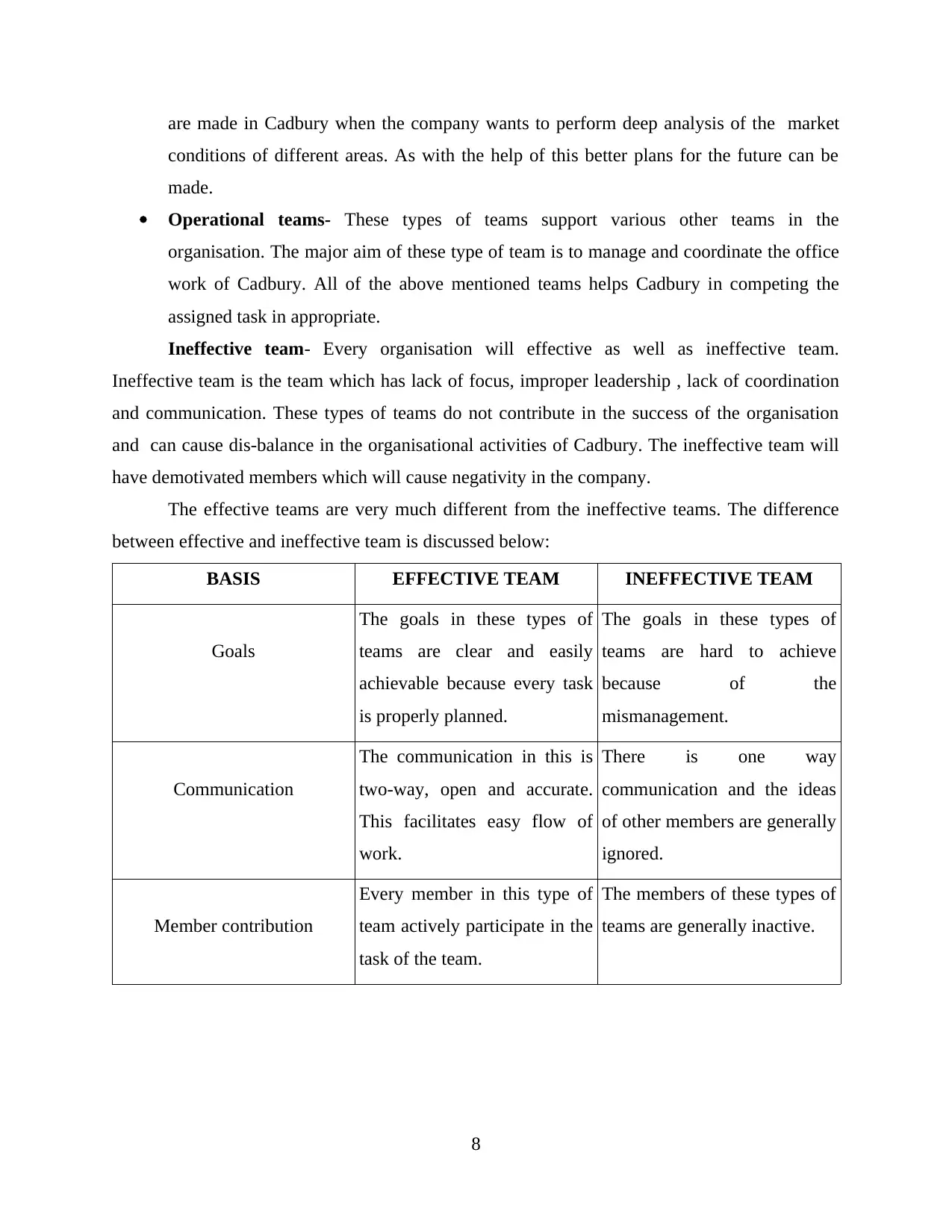
are made in Cadbury when the company wants to perform deep analysis of the market
conditions of different areas. As with the help of this better plans for the future can be
made.
Operational teams- These types of teams support various other teams in the
organisation. The major aim of these type of team is to manage and coordinate the office
work of Cadbury. All of the above mentioned teams helps Cadbury in competing the
assigned task in appropriate.
Ineffective team- Every organisation will effective as well as ineffective team.
Ineffective team is the team which has lack of focus, improper leadership , lack of coordination
and communication. These types of teams do not contribute in the success of the organisation
and can cause dis-balance in the organisational activities of Cadbury. The ineffective team will
have demotivated members which will cause negativity in the company.
The effective teams are very much different from the ineffective teams. The difference
between effective and ineffective team is discussed below:
BASIS EFFECTIVE TEAM INEFFECTIVE TEAM
Goals
The goals in these types of
teams are clear and easily
achievable because every task
is properly planned.
The goals in these types of
teams are hard to achieve
because of the
mismanagement.
Communication
The communication in this is
two-way, open and accurate.
This facilitates easy flow of
work.
There is one way
communication and the ideas
of other members are generally
ignored.
Member contribution
Every member in this type of
team actively participate in the
task of the team.
The members of these types of
teams are generally inactive.
8
conditions of different areas. As with the help of this better plans for the future can be
made.
Operational teams- These types of teams support various other teams in the
organisation. The major aim of these type of team is to manage and coordinate the office
work of Cadbury. All of the above mentioned teams helps Cadbury in competing the
assigned task in appropriate.
Ineffective team- Every organisation will effective as well as ineffective team.
Ineffective team is the team which has lack of focus, improper leadership , lack of coordination
and communication. These types of teams do not contribute in the success of the organisation
and can cause dis-balance in the organisational activities of Cadbury. The ineffective team will
have demotivated members which will cause negativity in the company.
The effective teams are very much different from the ineffective teams. The difference
between effective and ineffective team is discussed below:
BASIS EFFECTIVE TEAM INEFFECTIVE TEAM
Goals
The goals in these types of
teams are clear and easily
achievable because every task
is properly planned.
The goals in these types of
teams are hard to achieve
because of the
mismanagement.
Communication
The communication in this is
two-way, open and accurate.
This facilitates easy flow of
work.
There is one way
communication and the ideas
of other members are generally
ignored.
Member contribution
Every member in this type of
team actively participate in the
task of the team.
The members of these types of
teams are generally inactive.
8
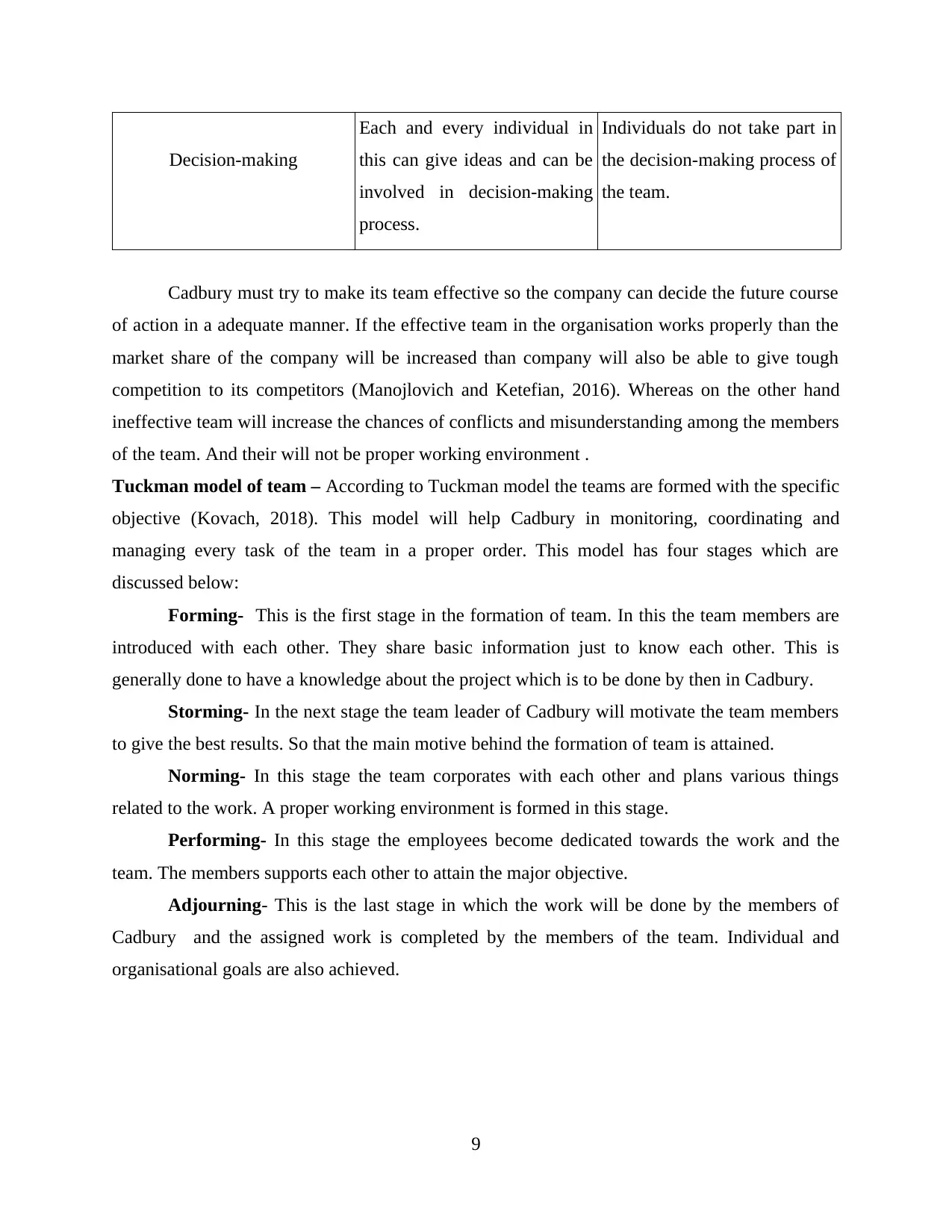
Decision-making
Each and every individual in
this can give ideas and can be
involved in decision-making
process.
Individuals do not take part in
the decision-making process of
the team.
Cadbury must try to make its team effective so the company can decide the future course
of action in a adequate manner. If the effective team in the organisation works properly than the
market share of the company will be increased than company will also be able to give tough
competition to its competitors (Manojlovich and Ketefian, 2016). Whereas on the other hand
ineffective team will increase the chances of conflicts and misunderstanding among the members
of the team. And their will not be proper working environment .
Tuckman model of team – According to Tuckman model the teams are formed with the specific
objective (Kovach, 2018). This model will help Cadbury in monitoring, coordinating and
managing every task of the team in a proper order. This model has four stages which are
discussed below:
Forming- This is the first stage in the formation of team. In this the team members are
introduced with each other. They share basic information just to know each other. This is
generally done to have a knowledge about the project which is to be done by then in Cadbury.
Storming- In the next stage the team leader of Cadbury will motivate the team members
to give the best results. So that the main motive behind the formation of team is attained.
Norming- In this stage the team corporates with each other and plans various things
related to the work. A proper working environment is formed in this stage.
Performing- In this stage the employees become dedicated towards the work and the
team. The members supports each other to attain the major objective.
Adjourning- This is the last stage in which the work will be done by the members of
Cadbury and the assigned work is completed by the members of the team. Individual and
organisational goals are also achieved.
9
Each and every individual in
this can give ideas and can be
involved in decision-making
process.
Individuals do not take part in
the decision-making process of
the team.
Cadbury must try to make its team effective so the company can decide the future course
of action in a adequate manner. If the effective team in the organisation works properly than the
market share of the company will be increased than company will also be able to give tough
competition to its competitors (Manojlovich and Ketefian, 2016). Whereas on the other hand
ineffective team will increase the chances of conflicts and misunderstanding among the members
of the team. And their will not be proper working environment .
Tuckman model of team – According to Tuckman model the teams are formed with the specific
objective (Kovach, 2018). This model will help Cadbury in monitoring, coordinating and
managing every task of the team in a proper order. This model has four stages which are
discussed below:
Forming- This is the first stage in the formation of team. In this the team members are
introduced with each other. They share basic information just to know each other. This is
generally done to have a knowledge about the project which is to be done by then in Cadbury.
Storming- In the next stage the team leader of Cadbury will motivate the team members
to give the best results. So that the main motive behind the formation of team is attained.
Norming- In this stage the team corporates with each other and plans various things
related to the work. A proper working environment is formed in this stage.
Performing- In this stage the employees become dedicated towards the work and the
team. The members supports each other to attain the major objective.
Adjourning- This is the last stage in which the work will be done by the members of
Cadbury and the assigned work is completed by the members of the team. Individual and
organisational goals are also achieved.
9
⊘ This is a preview!⊘
Do you want full access?
Subscribe today to unlock all pages.

Trusted by 1+ million students worldwide
1 out of 18
Related Documents
Your All-in-One AI-Powered Toolkit for Academic Success.
+13062052269
info@desklib.com
Available 24*7 on WhatsApp / Email
![[object Object]](/_next/static/media/star-bottom.7253800d.svg)
Unlock your academic potential
Copyright © 2020–2025 A2Z Services. All Rights Reserved. Developed and managed by ZUCOL.





